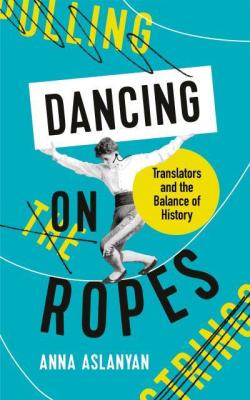Review by Karen Langley

As bookish people, when we think about translation we’re probably thinking about it in literary terms. There’s a rich seam of literature from other languages available to read for monolinguists, thanks to the efforts of all those marvellous translators out there. However, translation does, of course, have a much wider application and a new book, Dancing on Ropes by Anna Aslanyan, explores the uses of translation and interpretation in the real world, and how a slip in rendering words from one language to another can have potentially catastrophic consequences…
As well as being a journalist and literary translator, Aslanyan is a public service interpreter, and draws very much on her on her experience in that field for this book. Her exploration of the importance of translators is wide-ranging; although she opens with the bombing of Hiroshima, she travels far back to explore all manner of attempts by humans to communicate, taking in the Dragomans or court interpreters of the distant past up until the dramatic multi-translations required for the Nuremburg Trials, before coming up to date with the many faux pas of Donald Trump as well as exploring modern technological techniques. You might, of course, expect translation to be vital to mutual understanding of countries during the Cold War (and indeed some slips had wide-reaching effects); but a less obvious angle is the fact that a badly translated word leads to us still referring to the Canals of Mars when they really are no such thing!
The book is subtitled Translators and the Balance of History for a good reason, because as Aslanyan reveals, crucial events and decisions can hang in the balance, depending on the nuances of translation. In the middle of a complex negotiation process, for example, a misunderstood or mistranslated word or phrase can cause the whole undertaking to collapse. Wars can be started and peace initiatives halted through an interpreter not picking up a cultural nuance and relaying it to the recipient in a local form they would recognise. After having read this book, I have even more respect for translators and the range of knowledge they bring to their jobs. ‘Live’ public interpretation must be incredibly stressful, the kind of job where you’re concentrating every minute, and I hugely admire those who do this. I have nightmarish memories of having to translate passages off the cuff in French lessons at school, so anyone who can do this kind of thing for a living is laudable! The Nuremberg trials (mentioned earlier) were an incredibly complex undertaking with multiple translations needed, and ironically some of the multilingual defendants ended up assisting the translators…
It struck me strongly while reading this book that knowledge of a country’s culture is just as important as understanding its language. Misinterpreting a phrase or a local idiom can render a translation almost meaningless. Aslanyan discusses the art of translation itself, a complex and nuanced process, and her insights are fascinating. This leads to one particularly interesting section of the book which discusses the problems of machine translations, and will no doubt resonate with anyone who’s ever tried to make sense of anything produced by Google Translate. Artificial Intelligence does seem to be developing in leaps and bounds, but I personally don’t think machines can pick up the subtleties when negotiating the ground between two different cultures and languages – that comes, in my view, from the translators’ experience with, and knowledge of, them. The trouble is, machines are cheaper than people…
The book does cover literary translation and Aslanyan’s thoughts on the collaboration between translator and author made for such interesting reading. Of course, this is not always possible if the work being rendered into another language is from a long time ago; and although Aslanyan focuses on Borges and Thomas di Giovanni, more modern examples of the partnership between Maria Stepanova and Sasha Dugdale, or even Italo Calvino and William Weaver spring to mind. And of course, the Maudes worked with Tolstoy on their translations, so it does seem that some matches between author and translator are made in heaven!
Dancing on Ropes is always an interesting read, often a little shocking as you see what the errors of the past could and did do, and Aslanyan is an erudite and entertaining commentator. As a reader of literature from many languages I’ve always appreciated the work of translators; but this fascinating work has made me realise just how important they are in making the world go around!

Karen Langley blogs at kaggsysbookishramblings and as a monolinguist thinks translators are the bee’s knees.
Anna Aslanyan, Dancing on Ropes: Translators and the Balance of History (Profile Books, 2021). 978-1788162630, 272pp., hardback.
BUY at Blackwell’s via our affiliate link (free UK P&P)


This book sounds fascinating. I am also indebted to translators and in awe of interpreters – shame they’re often portrayed as manipulating the words they’re translating in films and tv.
Me too – my reading life would be poorer without translators, and interpreters are so immensely impressive. It’s a great read!
This sounds amazing and I will be procuring a copy forthwith! I work with translators and admire their skill every day, and I know at least one interpreter and have no idea how they do it!
It’s a fascinating read, and like you I admire translators and interpreters so much! I could never do what they do!
I remember working as an interpreter when I was younger and after a while I couldn’t remember which language I was speaking in anymore. It all blurred…
I can imagine – working in more than one language would throw me, so I’m hugely impressed at your skills!